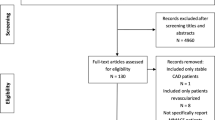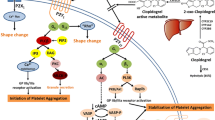Abstract
Aspirin (ASA) and clopidogrel have been identified as standard of care in the prevention of major cardiovascular events. Aspirin irreversibly inhibits the cyclooxygenase-1 (COX-1) enzyme, whereas non-steroidal anti-inflammatory drugs (NSAIDs) reversibly inhibit the COX-1 enzyme. An analysis of the literature revealed a statistically significant decrease in clinical benefit of ASA with concomitant administration of ibuprofen. Another NSAID, diclofenac, showed minimal effect on the inhibition of platelet aggregation when administered with ASA. Furthermore, the selective COX-2 inhibitor, rofecoxib, was not shown to influence the effect of ASA. Clopidogrel is metabolized to an active thiol metabolite by the CYP 3A4 enzyme. Some HMG CoA reductase inhibitors have the ability to inhibit the CYP 3A4 enzyme, which can result in a possible interaction if administered concomitantly with clopidogrel. Studies have demonstrated clopidogrel’s platelet inhibition being significantly attenuated by atorvastatin. However in a post-hoc analysis, it was demonstrated that there was no difference in clinical outcomes between patients taking clopidogrel and HMG-CoA reductase inhibitors metabolized by and not metabolized by CYP 3A4. Data suggest that the interaction observed involving clopidogrel and HMG-CoA reductase inhibitors appears to be significant in-vitro.
Therefore, practitioners should advise patients receiving chronic aspirin therapy to limit the use of ibuprofen and may consider concomitant administration of clopidogrel with HMG-CoA reductase inhibitors without regard for the drug interaction. The intent of this paper is to review the literature discussing possible mechanisms of drug-induced aspirin and clopidogrel resistance and discuss whether the interactions translate into clinical effects.
Similar content being viewed by others
References
Thom T, et al (2006) Heart disease and stroke statistics—2006 update: A report from the American Heart Association Statistics Committee and Stroke Statistics Subcommittee. Circulation 113(6):e85–151
Ryan TJ, et al (1999) 1999 update: ACC/AHA Guidelines for the management of patients with acute myocardial infarction: Executive summary and recommendations: A report of the American College of Cardiology/American Heart Association Task Force on Practice Guidelines (Committee on Management of Acute Myocardial Infarction). Circulation 100(9):1016–1030
Final report on the aspirin component of the ongoing Physicians’ Health Study (1989). Steering committee of the physicians’ health study research group. N Engl J Med 321(3):129–135
Thrombosis prevention trial: Randomised trial of low-intensity oral anticoagulation with warfarin and low-dose aspirin in the primary prevention of ischaemic heart disease in men at increased risk. The Medical Research Council’s General Practice Research Framework. Lancet 1998, 351(9098):233–241
Hansson L, et al. (1998) Effects of intensive blood-pressure lowering and low-dose aspirin in patients with hypertension: Principal results of the Hypertension Optimal Treatment (HOT) randomised trial HOT Study Group. Lancet 351(9118):1755–1762
de Gaetano G (2001) Low-dose aspirin and vitamin E in people at cardiovascular risk: A randomised trial in general practice. Collaborative Group of the Primary Prevention Project. Lancet 357(9250):89–95
A randomised, blinded, trial of clopidogrel versus aspirin in patients at risk of ischaemic events (CAPRIE). CAPRIE Steering Committee. Lancet 1996, 348(9038):1329–1339
Yusuf S, et al (2001) Effects of clopidogrel in addition to aspirin in patients with acute coronary syndromes without ST-segment elevation. N Engl J Med 345(7):494–502
Serebruany VL, et al (2003) Effects of clopidogrel and aspirin combination versus aspirin alone on platelet aggregation and major receptor expression in patients with heart failure: The Plavix Use for Treatment of Congestive Heart Failure (PLUTO-CHF) trial. Am Heart J 146(4):713–720
Mehta SR, et al (2001) Effects of pretreatment with clopidogrel and aspirin followed by long-term therapy in patients undergoing percutaneous coronary intervention: The PCI-CURE study. Lancet 358(9281):527–533
Sabatine MS, et al (2005) Addition of clopidogrel to aspirin and fibrinolytic therapy for myocardial infarction with ST-segment elevation. N Engl J Med 352(12):1179–1189
Braunwald E, et al (2002) ACC/AHA guideline update for the management of patients with unstable angina and non-ST-segment elevation myocardial infarction–2002: Summary article: A report of the American College of Cardiology/American Heart Association Task Force on Practice Guidelines (Committee on the Management of Patients With Unstable Angina). Circulation 106(14):1893–1900
Smith SC, Jr, et al (2006) ACC/AHA/SCAI 2005 Guideline update for percutaneous coronary intervention–summary article: A report of the American College of Cardiology/American Heart Association Task Force on Practice Guidelines (ACC/AHA/SCAI Writing Committee to Update the 2001 Guidelines for Percutaneous Coronary Intervention). Circulation 113(1):156–175
Bhatt DL, et al. (2006) Clopidogrel and aspirin versus aspirin alone for the prevention of atherothrombotic events. N Engl J Med.
Gum PA, et al (2003) A prospective, blinded determination of the natural history of aspirin resistance among stable patients with cardiovascular disease. J Am Coll Cardiol 41(6):961–965
Gum PA, et al (2001) Profile and prevalence of aspirin resistance in patients with cardiovascular disease. Am J Cardiol 88(3):230–235
Grundmann K, et al (2003) Aspirin non-responder status in patients with recurrent cerebral ischemic attacks. J Neurol 250(1):63–66
Grotemeyer KH, Scharafinski HW, Husstedt IW (1993) Two-year follow-up of aspirin responder and aspirin non responder. A pilot-study including 180 post-stroke patients. Thromb Res 71(5):397–403
Chen WH, et al (2004) Aspirin resistance is associated with a high incidence of myonecrosis after non-urgent percutaneous coronary intervention despite clopidogrel pretreatment. J Am Coll Cardiol 43(6):1122–1126
Matetzky S, et al (2004) Clopidogrel resistance is associated with increased risk of recurrent atherothrombotic events in patients with acute myocardial infarction. Circulation 109(25):3171–3175
Wiviott SD, Antman EM (2004) Clopidogrel resistance: A new chapter in a fast-moving story. Circulation 109(25):3064–3067
Jack DB (1997) One hundred years of aspirin. Lancet 350(9075): 437–439
Benedek IH, et al (1995) Variability in the pharmacokinetics and pharmacodynamics of low dose aspirin in healthy male volunteers. J Clin Pharmacol 35(12):1181–1186
Patrono C, et al (2005) Low-dose aspirin for the prevention of atherothrombosis. N Engl J Med 353(22):2373–2383
Juul-Moller S, et al (1992) Double-blind trial of aspirin in primary prevention of myocardial infarction in patients with stable chronic angina pectoris. The Swedish Angina Pectoris Aspirin Trial (SAPAT) Group. Lancet 340(8833):1421–1425
Risk of myocardial infarction and death during treatment with low dose aspirin and intravenous heparin in men with unstable coronary artery disease. The RISC Group. Lancet 1990, 336(8719):827–830
Swedish Aspirin Low-Dose Trial (SALT) of 75 mg aspirin as secondary prophylaxis after cerebrovascular ischaemic events. The SALT Collaborative Group. Lancet 1991, 338(8779):1345–1349
Collaborative overview of randomised trials of antiplatelet therapy–I: Prevention of death, myocardial infarction, and stroke by prolonged antiplatelet therapy in various categories of patients. Antiplatelet Trialists’ Collaboration. Bmj 1994, 308(6921):81–106
Helgason CM, et al (1994) Development of aspirin resistance in persons with previous ischemic stroke. Stroke 25(12):2331–2336
Pappas JM, Westengard JC, Bull BS (1994) Population variability in the effect of aspirin on platelet function. Implications for clinical trials and therapy. Arch Pathol Lab Med 118(8):801–804
Catella-Lawson, F et al (2001) Cyclooxygenase inhibitors and the antiplatelet effects of aspirin. N Engl J Med 345(25):1809–1817
Ross R (1999) Atherosclerosis–an inflammatory disease. N Engl J Med 340(2):115–126
MacDonald TM, Wei L (2003) Effect of ibuprofen on cardioprotective effect of aspirin. Lancet 361(9357):573–574
Kurth T, et al (2003) Inhibition of clinical benefits of aspirin on first myocardial infarction by nonsteroidal antiinflammatory drugs. Circulation 108(10):1191–1195
Jermany J, et al (2005) Lumiracoxib does not affect the ex vivo antiplatelet aggregation activity of low-dose aspirin in healthy subjects. J Clin Pharmacol 45(10):1172–1178
Capone ML, et al (2005) Pharmacodynamic interaction of naproxen with low-dose aspirin in healthy subjects. J Am Coll Cardiol 45(8):1295–1301
Pereillo JM, et al (2002) Structure and stereochemistry of the active metabolite of clopidogrel. Drug Metab Dispos 30(11):1288–1295
Reist M, et al (2000) Very slow chiral inversion of clopidogrel in rats: A pharmacokinetic and mechanistic investigation. Drug Metab Dispos 28(12):1405–1410
Gurbel PA, et al (2003) Onset and extent of platelet inhibition by clopidogrel loading in patients undergoing elective coronary stenting: The Plavix Reduction of New Thrombus occurrence (PRONTO) trial. Am Heart J 145(2):239–247
Gurbel PA, et al (2005) The relation of dosing to clopidogrel responsiveness and the incidence of high post-treatment platelet aggregation in patients undergoing coronary stenting. J Am Coll Cardiol 45(9):1392–1396
Clarke TA, Waskell LA (2003) The metabolism of clopidogrel is catalyzed by human cytochrome P450 3A and is inhibited by atorvastatin. Drug Metab Dispos 31(1):53–59
Ding Z, et al (2003) Inactivation of the human P2Y12 receptor by thiol reagents requires interaction with both extracellular cysteine residues, Cys17 and Cys270. Blood 101(10):3908–3914
Daniel JL, et al (1998) Molecular basis for ADP-induced platelet activation. I. Evidence for three distinct ADP receptors on human platelets. J Biol Chem 273(4):2024–2029
Geiger J, et al (1999) Specific impairment of human platelet P2Y(AC) ADP receptor-mediated signaling by the antiplatelet drug clopidogrel. Arterioscler Thromb Vasc Biol 19(8):2007–2011
Horstrup K, et al (1994) Phosphorylation of focal adhesion vasodilator-stimulated phosphoprotein at Ser157 in intact human platelets correlates with fibrinogen receptor inhibition. Eur J Biochem 225(1):21–27
Savi P, et al (1994) Binding of [3H]-2-methylthio ADP to rat platelets–effect of clopidogrel and ticlopidine. J Pharmacol Exp Ther 269(2):772–777
Shattil SJ, Kashiwagi H, Pampori N (1998) Integrin signaling: The platelet paradigm. Blood 91(8):2645–2657
Storey RF, et al (2002) Inhibition of ADP-induced P-selectin expression and platelet-leukocyte conjugate formation by clopidogrel and the P2Y12 receptor antagonist AR-C69931MX but not aspirin. Thromb Haemost 88(3):488–494
Cannon CP, et al (2004) Intensive versus moderate lipid lowering with statins after acute coronary syndromes. N Engl J Med 350(15):1495–1504
Lau WC, et al (2003) Atorvastatin reduces the ability of clopidogrel to inhibit platelet aggregation: A new drug-drug interaction. Circulation 107(1):32–37
Neubauer H, et al (2003) Lipophilic statins interfere with the inhibitory effects of clopidogrel on platelet function—A flow cytometry study. Eur Heart J 24(19):1744–1749
Serebruany VL, et al (2004) Absence of interaction between atorvastatin or other statins and clopidogrel: Results from the interaction study. Arch Intern Med 164(18):2051–2057
Saw J, et al (2003) Lack of adverse clopidogrel-atorvastatin clinical interaction from secondary analysis of a randomized, placebo-controlled clopidogrel trial. Circulation 108(8):921–924
Mitsios JV, et al (2005) The inhibitory potency of clopidogrel on ADP-induced platelet activation is not attenuated when it is co-administered with atorvastatin (20 mg/day) for 5 weeks in patients with acute coronary syndromes. Platelets 16(5):287–292
Mukherjee D, et al (2005) Lack of clopidogrel-CYP3A4 statin interaction in patients with acute coronary syndrome. Heart 91(1):23–26
Author information
Authors and Affiliations
Corresponding author
Rights and permissions
About this article
Cite this article
Schroeder, W.S., Ghobrial, L. & Gandhi, P.J. Possible mechanisms of drug-induced aspirin and clopidogrel resistance. J Thromb Thrombolysis 22, 139–150 (2006). https://doi.org/10.1007/s11239-006-8670-y
Issue Date:
DOI: https://doi.org/10.1007/s11239-006-8670-y




